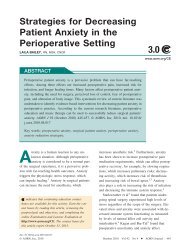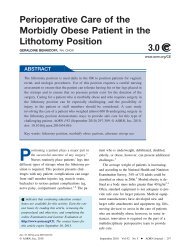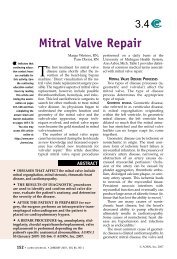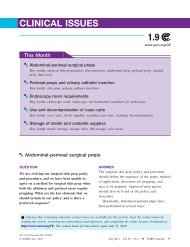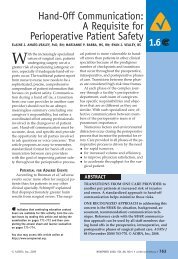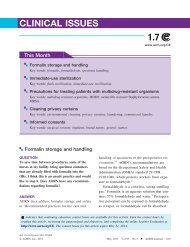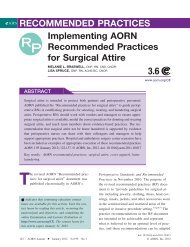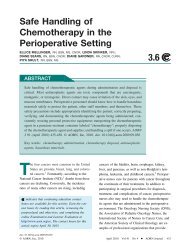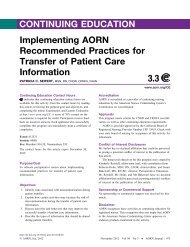Responding to Amniotic Fluid Embolism - AORN
Responding to Amniotic Fluid Embolism - AORN
Responding to Amniotic Fluid Embolism - AORN
You also want an ePaper? Increase the reach of your titles
YUMPU automatically turns print PDFs into web optimized ePapers that Google loves.
JUNE 2009, VOL 89, NO 6Dobbenga-Rhodescase, caregivers should transport the patient <strong>to</strong>the OR as quickly and safely as possible. Ongoingcare should be shared between the perinataland perioperative nursing staff members. Manyperinatal units do not require staff members <strong>to</strong>be certified in advanced cardiac life support, sothe advanced education and experience of perioperativenurses will complement the basic lifesupport measures already implemented.CIRCULATORY SUPPORT. In accordance with thebasics of cardiopulmonary resuscitation, circula<strong>to</strong>rysupport is the next goal in the resuscitationof the patient with AFE. Medical andnursing staff members should quickly establisha large-bore peripheral IVcatheter, a central venouspressure catheter, a pulmo -nary artery catheter, and aperipheral arterial line. Gatheringadditional resources andmanpower from the anesthesiaand critical care staffs will helpsupport the resuscitation teamduring this emergency. 36,37Transthoracic or transesopha -geal echocardio graphy (TEE) isoften necessary <strong>to</strong> evaluate cardiacfunction and <strong>to</strong> guidetreatment, along with a 12-leadECG. 3 As time allows and asequipment is made available,the TEE may demonstrate theacute right ventricular overload,severe pulmonary arteryhypertension, and marked dias<strong>to</strong>lic dysfunctionof the left ventricle secondary <strong>to</strong> a dilated rightventricle. 29,38Use of the peripheral IV catheter should belimited <strong>to</strong> loading with crystalloid, colloid,packed cells, fresh frozen plasma, and platelets.If profound hemorrhage occurs, a transfusionof uncross-matched O-negative packed cells isrecommended so transfusion is not delayed bywaiting for type-specific and cross-matchedblood. 15 Hemofiltration 39 or plasma exchange 40may be effective in clearing the maternal plasmaof potential fetal debris. 10 Hemofiltration isthe removal of waste product from the bloodby passing it through extracorporeal filters.Plasma exchange consists of removal of blood,These patients arepredisposed <strong>to</strong> pulmonaryedema so their centralline readings should bemoni<strong>to</strong>red closely <strong>to</strong>avoid over-hydration.separation of blood cells from plasma, and returnof these blood cells <strong>to</strong> the body’s circulation,diluted with fresh plasma. A transfusion of1.5 times the maternal blood volume may act asa complete exchange transfusion; 41 however,cryo precipitate is particularly useful in AFEbecause it can be used <strong>to</strong> replenish clotting fac<strong>to</strong>rsin lieu of fresh frozen plasma in volumerestrictedpatients. In addition, cryoprecipitatecontains both fibrinogen and fibronectin, whichfacilitate the removal of cellular and particulatematter from the blood via the reticuloendothelial(ie, the mononuclear phagocyte) system. 33,42Thrombocy<strong>to</strong>penia can be treated with the administrationof platelets. 36Arterial lines can be used <strong>to</strong>regulate pressures, moni<strong>to</strong>roxygen saturation, and assistwith titration of inotropes.Specific inotropic medicationssuch as dopamine, dobutamine,and norepinephrine enhancehemodynamic stabilityby maintaining cardiac outputand blood pressure. Readingsfrom central lines should bemoni<strong>to</strong>red closely <strong>to</strong> avoidover-hydration of these patientswho are predisposed <strong>to</strong>pulmonary edema. Noncardiogenicpulmonary edemadevelops in 70% of AFE patients,possibly because of theeffect of various media<strong>to</strong>rs ofanaphylaxis such as histamine and bradykininsleading <strong>to</strong> capillary leak syndrome. 43 The anesthesiacare provider can draw blood specimensfrom these lines and send them for analysis <strong>to</strong>assist with interpretation and correction of coagulopathyas well as for cy<strong>to</strong>logic analysis foramniotic fluid in the maternal patient’s circulation.33 Rapid assessments may be availablefrom a point-of-care device, typically accessiblein the perioperative setting.Nursing personnel should see that coagulationstudies for prothrombin time, partialthromboplastin time, D-dimer, fibrin split products,and platelets are sent immediately <strong>to</strong> thelabora<strong>to</strong>ry for analysis. Coagulopathy and hemorrhageare common and often occur after the1084 • <strong>AORN</strong> JOURNAL



